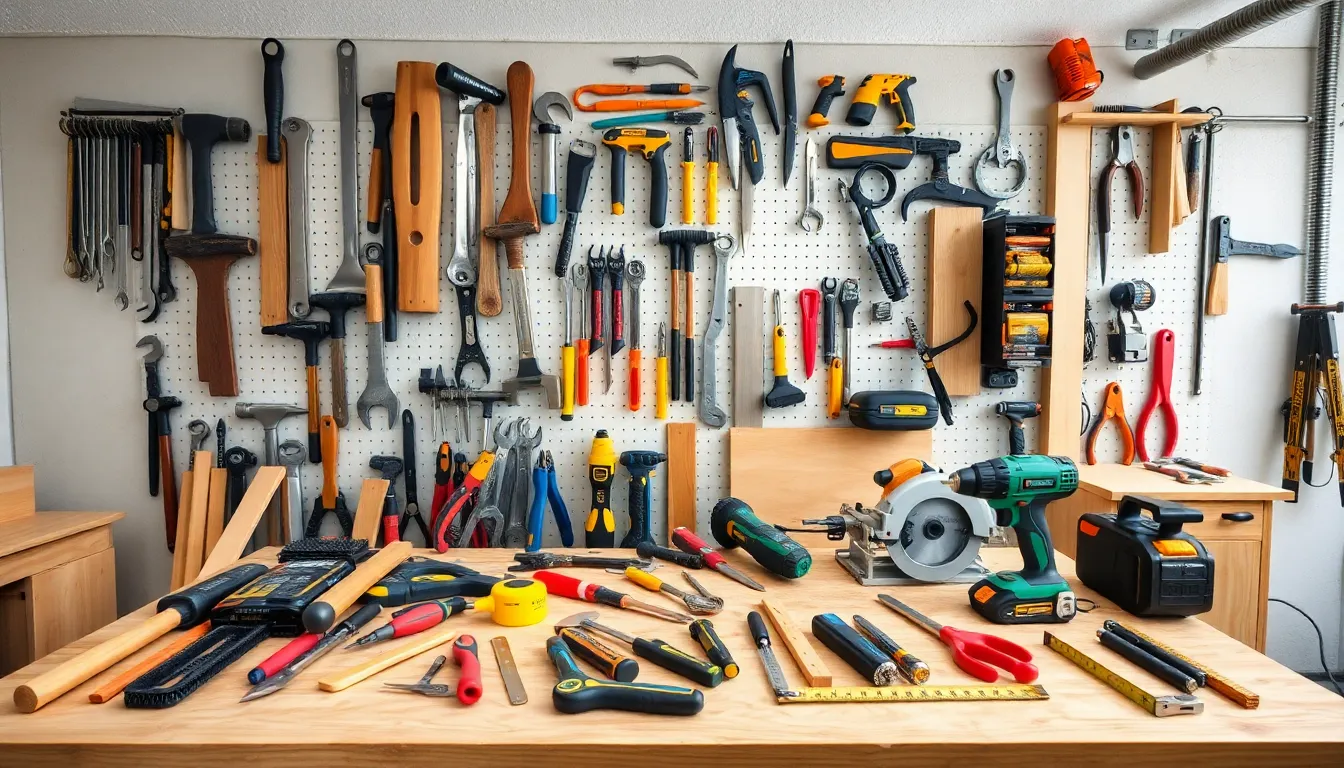Ever stepped into a workshop and felt lost amidst a sea of gadgets and gizmos? Worry not. Understanding workshop tools and equipment doesn’t have to feel like deciphering an ancient language. This guide is here to break it down, from essential hand tools to the latest power tools, ensuring you tackle your next project with the confidence of a seasoned pro, and maybe even a chuckle or two along the way.
Table of Contents
ToggleEssential Hand Tools

When it comes to workshop essentials, hand tools are the backbone of any operation. Whether he’s a hobbyist or a seasoned craftsman, one must appreciate the value of reliable hand tools. A good toolkit begins with the basics:
- Hammers: Not just for hanging pictures. Hammers come in various types like claw and sledgehammer, serving different functions.
- Screwdrivers: From Phillips to flathead, every project requires the right screwdriver to match. Having a complete set will save time and frustration.
- Pliers: Whether gripping, bending, or cutting, pliers are indispensable. Needle-nose pliers are compact and convenient for intricate work.
- Wrenches: Adjustable wrenches provide versatility, accommodating different sizes of nuts and bolts.
- Cutting Tools: Such as hand saws and utility knives are crucial for precise cuts in various materials.
Each tool plays a pivotal role, transforming an ordinary project into a masterpiece. Who knew a simple hammer could be the MVP of the tool box?
Power Tools Overview
Power tools are a game changer in any workshop. They make tackling hefty projects feel like a walk in the park. Here’s a rundown of some popular options:
- Drills: Cordless drills offer freedom of movement, perfect for drilling holes or driving screws efficiently. They can even tackle tougher materials with the right bit.
- Saw Variants: From circular saws to jigsaws, each type excels in cutting different materials. A circular saw can rip through wood like butter, while a jigsaw is great for intricate designs.
- Sanders: Electric sanders save precious time during finishing work, ensuring surfaces are smooth and ready for paint or varnish.
- Grinders: Useful for metal and masonry tasks, grinders like angle grinders can perform cuts, grind surfaces, and polish materials too.
Overall, while hand tools are fantastic for fine tasks, power tools give that extra punch when tackling large jobs.
Measuring And Layout Tools
Measurements can make or break a project, and layout tools are essential:
- Tape Measures: A staple in every toolbox, tape measures come in various lengths and styles. Magnetic tape measures can even stick to metal surfaces.
- Squares: Whether framing a wall or creating a layout, squares like the carpenter’s square ensure everything is right-angled.
- Levels: No builder wants a slanted shelf. Levels like spirit levels guarantee a bubble is centered for perfect horizontal or vertical alignment.
- Marking Tools: Pencils and markers specifically designed for surfaces can save you when layout becomes tricky.
Without these tools, DIY projects could turn into DIY disasters, accurate measurements lead to better outcomes.
Storage And Organization Solutions
A well-organized workshop can boost productivity. Nothing derails creativity faster than searching for a misplaced tool. Here are some top storage tips:
- Toolboxes and Chests: Invest in a sturdy toolbox that complements your workspace. A rolling toolbox adds portability for mobile workshops.
- Shelving Units: Open shelving allows easy access to frequently used items. Plus, it makes great use of vertical space.
- Pegboards: Perfect for hanging tools, pegboards keep everything visible and within reach. Customizing layouts can maximize efficiency.
- Drawer Systems: Divide tools and materials into different drawers for quick access. Keep the little stuff, like screws and nails, sorted to avoid chaos.
When organization reigns, creativity thrives. No more digging through piles to find that elusive screwdriver.
Safety Equipment And Best Practices
Safety should never be an afterthought in the workshop. Here’s a checklist of must-have safety gear:
- Safety Glasses: Protect those peepers from flying debris. Safety glasses are your best friend whether drilling or cutting.
- Ear Protection: Power tools can be noisy. Earplugs or earmuffs help protect hearing during those extended DIY sessions.
- Dust Masks: Important when sanding or using certain materials. Keeping inhalation risks low is critical for long-term health.
- Work Gloves: Provides grip while protecting hands from cuts and abrasions.
Also, always follow best practices: Keep your workspace clean, take breaks to stay sharp, and never hesitate to ask for help with tricky tasks. Safety doesn’t just protect individuals: it ensures everyone goes home unharmed.
Maintaining Your Tools And Equipment
Taking care of workshop tools prolongs their life and enhances performance. Here are some essential maintenance tips:
- Keep Them Clean: Regularly clean tools after use. Washing off dust and grime reduces wear and tear.
- Check for Damage: Performing routine inspections helps catch potential issues before they lead to malfunction.
- Sharpen Blades: Tools like chisels and saws need sharpening. Dull blades can ruin your work and increase injury risks.
- Proper Storage: Store in dry, climate-controlled environments. Moisture damages tools, leading to rust and corrosion.
These practices ensure tools remain functional and reliable over time, making them ready for any challenge ahead.




